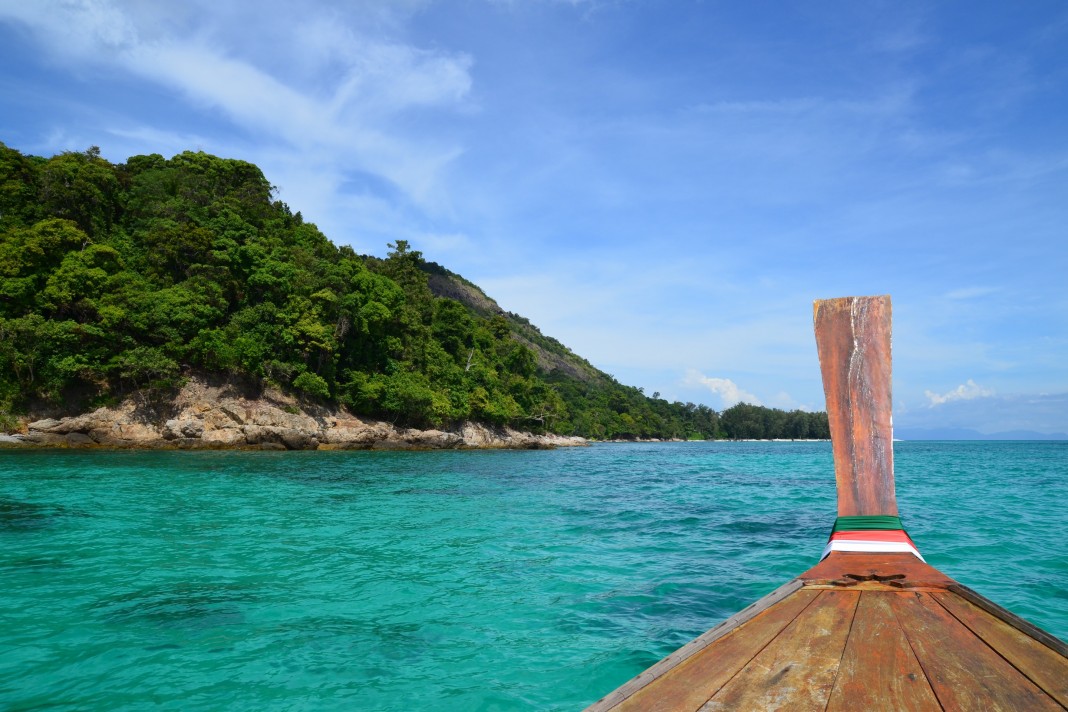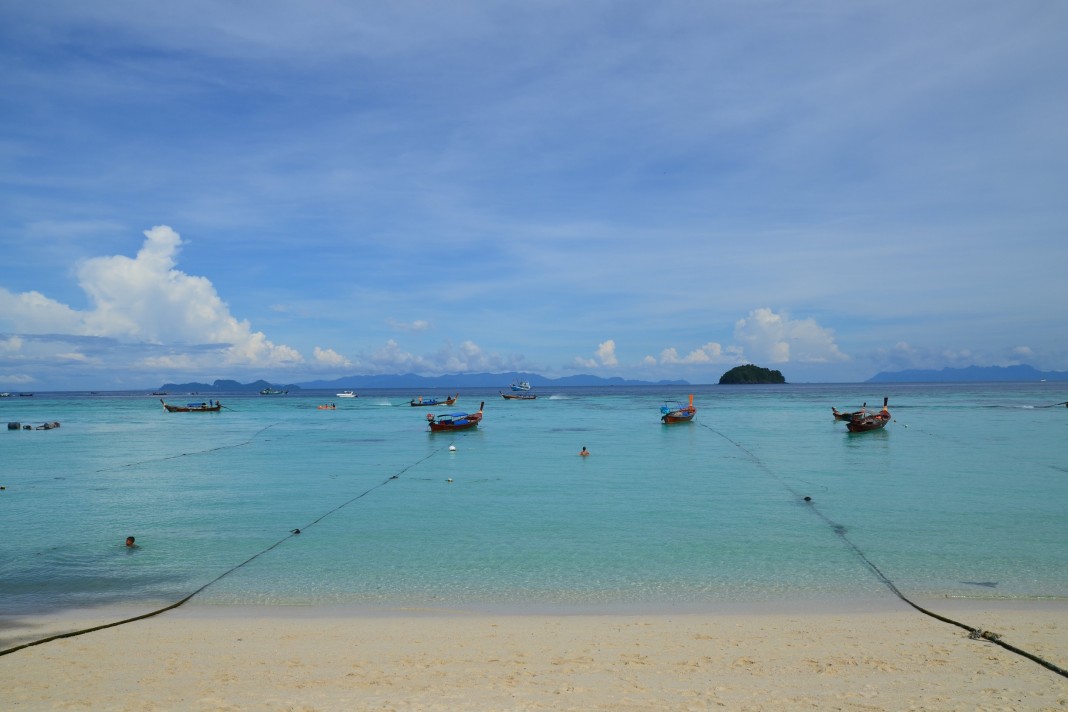Introduction
The islands on our main itinerary include popularity contest winners Ko Lipe and Ko Lanta, but also offbeat spots that we’ve taken a shine to, like Ko Bulon Lae and Ko Jum. In addition we mention several other islands to keep in mind for day trips or alternative side trips. Rather than thinking of this itinerary as a rigid plan, view it as a sketch—or a menu, perhaps—and use it to help you wring out a route that fits you best. We arranged our route from north down, but you could easily flip it and start in the south.

In total, 24 islands found off some 300 km of coastline are mentioned, but hitting even a dozen islands in a month would be ambitious. If you’re more into relaxing than exploring, pick no more than one island per week and sprinkle in day trips when needing a break from the hammock. If you don’t mind travel by sea, boats pull right up to the beach on most islands, and we think this is the most enjoyable island hopping in Thailand. As we type this in Bangkok we’re employing serious willpower to stop ourselves from catching the next flight down there. Enjoy.
Getting around
Airports are found to the north at Phuket and Krabi, where ferries to Ko Phi Phi and Ko Lanta are available; and in the south at Hat Yai and Malaysia’s Langkawi Island, both of which are jumping off points for Ko Lipe. Trang also has an airport and train station if you want to start in the middle, at Ko Muk for example. All of the mainland centres can be reached by bus as well, and there’s an additional train station in Hat Yai in case you’re coming north from Malaysia by rail.

In high season, public boats make it possible to hop from one island to the next without returning to the mainland at all. There are three main island hopping companies: Tigerline uses medium-size ferries while Bundhaya and Satun Pakbara employ speedboats. These stop at six to nine islands per day in both directions; don’t expect punctuality. Travel agents in every destination sell tickets for 250 to 1,200 baht per person. Private longtail boats can also be helpful—and more fun—for certain legs and day tours. A few liveaboard dive boats ply the area as well.
If at any time you want to return the mainland, public boats connect all but the remote national park islands to piers in Krabi, Trang or Pakbara. These range from large air-con ferries to speedboats and small longtails on which you might be sitting next to a goat. You can buy boat tickets in person through travel agents or online through sites like 12Go. Private longtails can always be arranged direct with the boat drivers.

Most of these islands are small and best explored on foot, bicycle or kayak. Some, like Ko Kradan, have no roads at all. Ko Lanta, Ko Jum and a few others are large enough for scooters—if you plan to rent one, please make the time to learn to ride and get a license in your home country, and always wear a helmet. If you’re thinking of riding without an international motorcycle license, you may want to read up on the travel insurance implications first.
When to go
Unless you’re willing to repeatedly return to the mainland between islands, this itinerary only works when public island-hopping boats operate in high season from 1st November to 30th March. The shoulder months of November and March see thinner crowds and room rates that are a bit lower than during peak season from December through February. Pre-booking rooms is a good idea at any time in high season, especially for Ko Phi Phi, Ko Lipe and Ko Kradan. Don’t be surprised if tents are all that’s left if you show up on these islands around Christmas or Chinese New Year without a reservation.

This region sees a lot of rain from May through October, a time when many resorts close on obscure islands like Ko Bulon Lae. July, August and September tend to be the wettest months. Most accommodation on the popular islands stays open year round and rates drop by 50% or more in low season, but the sea is often too rough for boat trips and the snorkelling can be murky. Most islands controlled entirely by national parks, including Ko Rok and Ko Tarutao, close from May through October.
Day by day
Days 1-4: Ko Phi Phi
Ko Phi Phi is one of the most popular islands not only in this itinerary, but also in Thailand at large. Yes, concrete room blocks and speedboat engines have spoiled some of the natural beauty, but the lively nightlife scene keeps drawing in younger travellers (and the young at heart) and you can still find a quiet bungalow in more distant bays. The turquoise water and dramatic cliffs look at dazzling today as they did when Phi Phi first fell onto the radar in the late 1980s.

It’s actually a pair of islands with the larger Ko Phi Phi Don containing all of the resorts, bars and travel offices. Home to the gorgeous yet often overcrowded Maya Bay, where Leonardo Dicaprio swam with sharks in The Beach, Ko Phi Phi Leh is a national park island best hit on an early-morning day trip. Any of several diving outfits will take you to explore several shipwrecks and reefs around uninhabited islands like Ko Bida, Ko Mai Pai and Ko Poda.
If Phi Phi does not sound like your cup of tea, feel free to skip it and start the trip by heading straight from Krabi town to Ko Jum or Ko Lanta, perhaps with a detour at the rock-climbing hub of Railay along the way.
Days 5-8: Ko Jum
The two villages set on opposite ends of this island each use a different name for it—the northern part set around a cone-shaped mountain is known as Ko Pu, while the coconut tree studded south goes by Ko Jum. Think of it as a smaller, shyer and less developed sibling of neighbouring Ko Lanta. If strolling on miles-long beaches before listening to the waves beneath a mosquito net after dark sounds good to you, factor in a stop on Ko Jum.

Most people spend their time swaying in a hammock between games of Go Fish. Do at least pay a visit to the island’s languid Muslim-Thai fishing villages (and do be respectful by covering up with appropriate garb when away from the beach). You could also link up with Koh Jum Divers to hit sites more commonly reached from Lanta and Phi Phi. Lovers of land-based nature should join a local guide on a trek up Ko Pu for wildlife spotting and great views from the summit.
... Travelfish members only (Full text is around 1,800 words.)Log in to Travelfish
Please sign in to read the rest of this page. The full text is around 1,800 words.
Become a Travelfish member
Choose from $10 week-long through to a lifetime membership.
Reviewed by
David Luekens
David Luekens first came to Thailand in 2005 when Thai friends from his former home of Burlington, Vermont led him on a life-changing trip. Based in Thailand since 2011, he spends much of his time eating in Bangkok street markets and island hopping the Andaman Sea. David is also the founder of Thai Island Quest—a newsletter focused on covering every island and beach in Thailand.